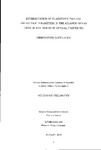DETERMINATION OF PLANKTONIC PRIMARY PRODUCTION PARAMETERS IN THE ATLANTIC OCEAN USING IN SITU INHERENT OPTICAL PROPERTIES
| dc.contributor.author | LOWE, CHRISTOPHER DAVID | |
| dc.contributor.other | Faculty of Science and Engineering | en_US |
| dc.date.accessioned | 2013-10-22T09:04:27Z | |
| dc.date.available | 2013-10-22T09:04:27Z | |
| dc.date.issued | 2005 | |
| dc.identifier | NOT AVAILABLE | en_US |
| dc.identifier.uri | http://hdl.handle.net/10026.1/2267 | |
| dc.description.abstract |
Bio-optical measurements from three of the Atlantic Meridional Transect programme cruises in 2003-2004 were examined to determine spatial variation and correlations between phytoplankton variables. These cruises each crossed approximately 100° of latitude between the UK and the Falkland Islands, covering a range of environments in the Atlantic Ocean. Measurements of primary production were made using a Fast Repetition Rate Fluorometer (FRRF), concentration of phytoplankton pigments using High Performance Liquid Clrromatography (HPLC) and in situ particle absorption using a novel double cast technique with an ac9+ nine wavelength absorption/attenuation meter. Ancillary data in the form of salinity, temperature and chlorophyll concentration profiles were used to determine the spatial distribution of communities and to provide data for calibration. Cluster analysis of pigment data, using multivariate Brae-Curtis statistical analysis, produced effective partitioning of the cruises into functional regions for further work. The study showed that reference blanking was important in oceanic measurements with the FRRF and that separate blanks were required for each chamber. Blanks of unfiltered water from below the euphotic zone coincided best with blanks taken under in situ irradiance in the water column. Positive log linear relationships were shown between FRRF photosynthetic quantum efficiency (Fu/Fm) and, contrary to expectations, between photosystem 11 cross sectional area (σPSII) and measurements of chlorophyll a concentration. Comparisons between FRRF and automated flow cytometry data suggested that the photochemistries of the prokaryotes Synecococcus and Prochlorococcus are significantly different and that the photochemistry of Prochlorococcus is similar to that of eukaryotes. The concentration ratio of chlorophyll α: total pigment was found to follow a positive log linear relationship with chlorophyll a concentration, similar to that of the FRRF variables. A possible causative link between the relative loads of chlorophyll a and total pigment with FRRF variables was suggested. The novel twin filtered and unfiltered casts of the ac9+ produced acceptable particulate absorption spectra. Spectra representing chlorophyll a and total pigment concentrations demonstrated the same positive log linear relationship of the pigment measurements suggesting that this method could be used to determine pigment concentrations and therefore primary production parameters. Direct correlations were found between FRRF primary production parameters and both pigment ratios and absorption ratios, suggesting that absorption measurements could be used to a proxy for primary production parameters. | en_US |
| dc.description.sponsorship | Plymouth Marine Laboratory | en_US |
| dc.language.iso | en | en_US |
| dc.publisher | University of Plymouth | en_US |
| dc.title | DETERMINATION OF PLANKTONIC PRIMARY PRODUCTION PARAMETERS IN THE ATLANTIC OCEAN USING IN SITU INHERENT OPTICAL PROPERTIES | en_US |
| dc.type | Thesis | |
| dc.identifier.doi | http://dx.doi.org/10.24382/3865 |
Files in this item
This item appears in the following Collection(s)
-
01 Research Theses Main Collection
Research Theses Main


